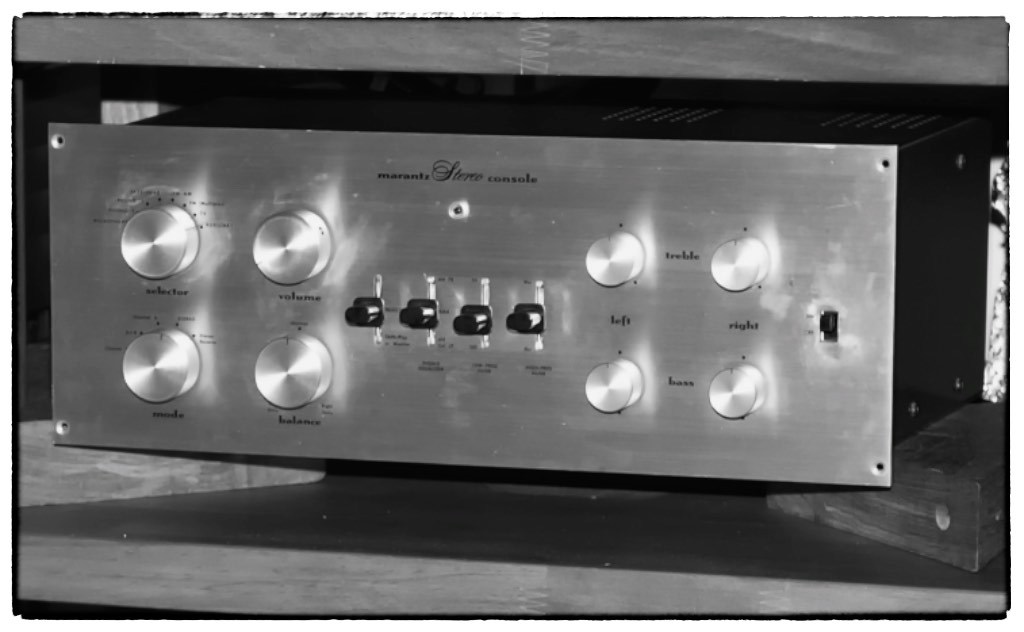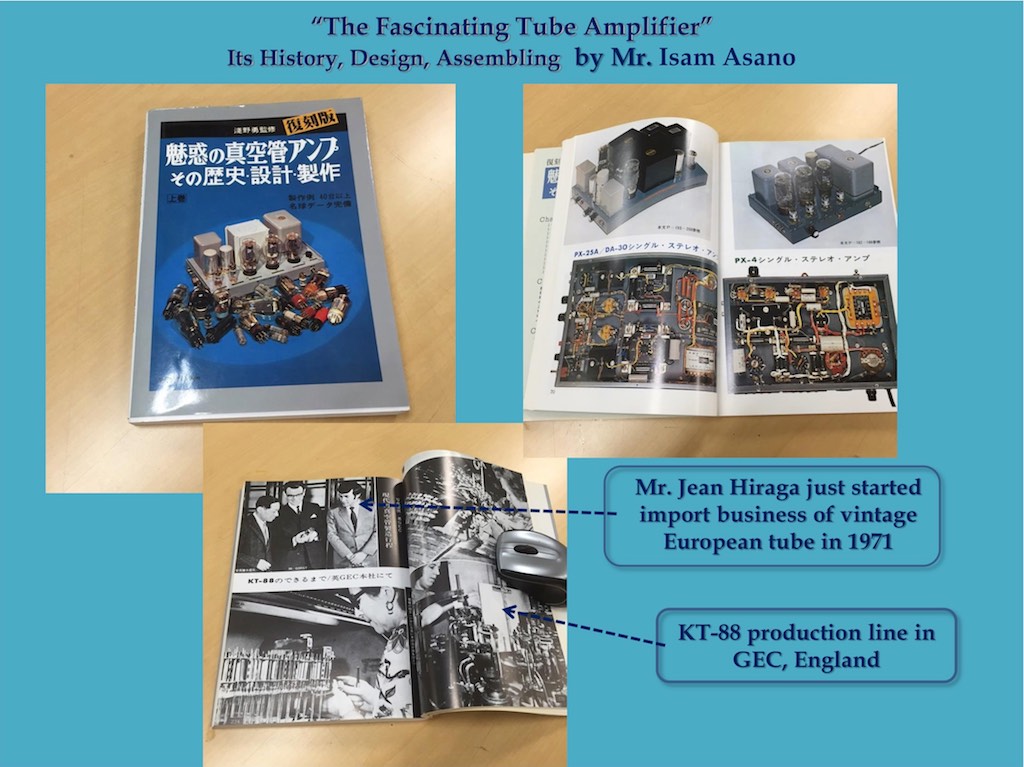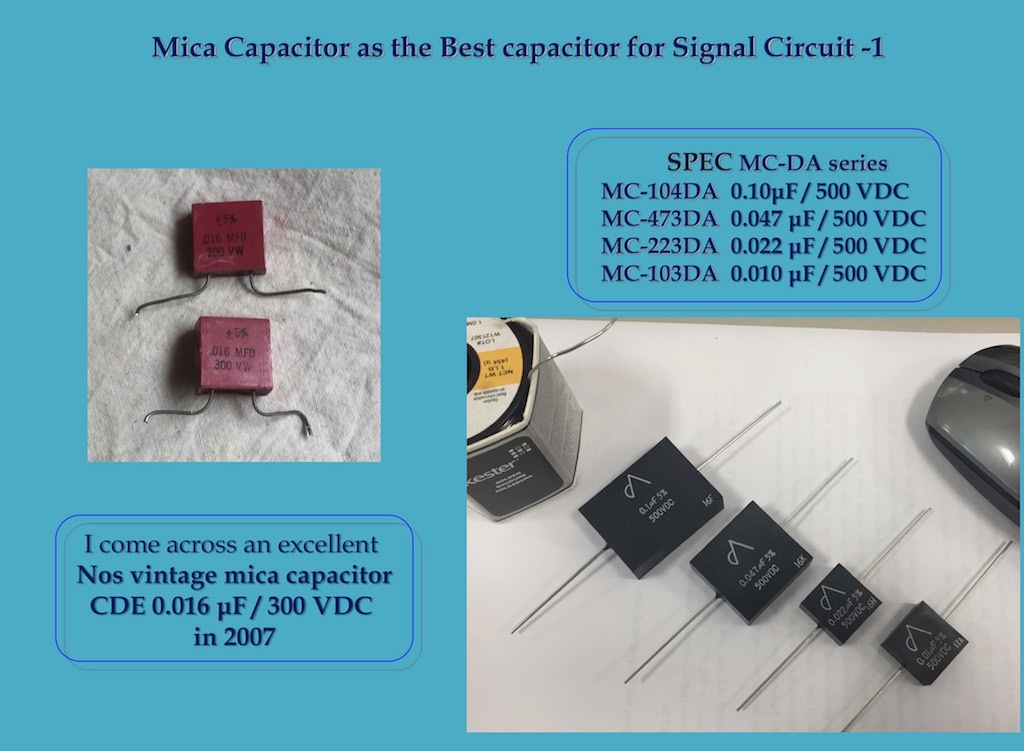It has been a great pleasure to bring you posts from Yazaki-san for his article “My Adventure With My Old Marantz Model 7”.
Many thanks to Yazaki-san for taking time to write this article and share his substantial audio wisdom with us, it is very much appreciated by me, as well as all of us here at Jeff’s Place!
¸¸.•*¨*•♫♪¸¸.•*¨*•♫♪¸¸.•*¨*•♫♪
In Part 1 Yazaki-san told us about his near forty year passion of pursuing ‘real sound’ with his vintage Marantz Model 7 preamplifier, and the resulting enjoyment & satisfaction that pursuit has brought to his life.
Yazaki-san shared with us his thoughts about several brilliant design aspects of the Marantz Model 7, and how its design allows it to still hold its own against, or even surpass, anything made today in musical ‘real sound’ terms.
Yazaki-san also told us about his approach for fine-tuning the Model 7’s performance for ‘real sound’ through a careful selection of internal parts like capacitors and resistors, and finally, hinted at the modifications he was going to tell us about in Part 2 of his article that would take the Model 7’s performance to an even higher level.
¸¸.•*¨*•♫♪¸¸.•*¨*•♫♪¸¸.•*¨*•♫♪
In Part 2 Yazaki-san told us about his way of modification with his Marantz Model 7, and how important the quality of the power supply is to the overall performance, because the current from the power supply turns into the signal current.
Yazaki-san described for us how the switch to the Ultra-Fast & Soft Recovery STTH6112TV2 for +B rectification improved the speed of the current from the power supply, and lowered the noise.
Yazaki-san also described for us how he likes to install a hermetically sealed oil-filled capacitor into the subsequent stage of the rectifier tube or diode, connected in parallel with the main electrolytic capacitor for rectification, and how that its addition provides a more responsive and organic sound.
¸¸.•*¨*•♫♪¸¸.•*¨*•♫♪¸¸.•*¨*•♫♪
In Part 3 Yazaki-san told us about his discovery of how the addition of a decoupling capacitor for the +B voltage line (280 VDC for V3 and V6) of the cathode follower in the Marantz Model 7, brought about such an important improvement to the sound quality.
Yazaki-san also described how to bring out the full potential of π filters by using Ohmite Brown Devil resistors in place of the original Allen Bradley resistors used in the Model 7, and how the inductance of various wattage ratings affected the overall performance and voicing.
Now, without further ado, let me introduce you to Yazaki-san's Part 4 of his article, where he discusses upgrading the coupling capacitors!
¸¸.•*¨*•♫♪¸¸.•*¨*•♫♪¸¸.•*¨*•♫♪
My Adventure with My Old Marantz Model 7k
Part 4: My Way of Modification - Upgrading the Coupling Capacitors
Dedicated to Saul B Marantz and Sidney Smith for their true masterpiece!
By
Shirokazu Yazaki
The Mica Capacitor As the Best Capacitor for Signal Circuit
At the beginning of writing this chapter, I would like to talk about the fact that I have developed and produced our mica capacitor, the MC-DA series, specialized for our audio use, and have also worked closely with Arizona Capacitors, Inc., in Tucson, Arizona, to develop the Red, Blue, Green Cactus capacitors over the last seven years.
And so I’m afraid that my writing about them could be somewhat less objective than usual because of my passionate feeling for the performance of these capacitors.
I think the most important matter for the readers of Jeff’s Place would be the truthful confession of my own “Capacitor Adventure,” because when we get to the core of our audio hobby, it must be only the accumulation of experiences for each enthusiast that guides our preferences, and so I would like to express my own experiences through the long years as honestly as possible.
I learned about the use of mica capacitors, more than 35 years ago now, by the masterwork of Isamu Asano-san, from “The Fascinating Tube Amplifier, Its history, Design and Assembly”, published in 1971, as an MJ special edition book.
At that time, the first tube amplifier boom was full bloom in Japan, and also young Jean Hiraga-san just introduced us European vintage tubes, especially those made in England.
Asano-san’s writings covered almost all of the vintage tubes, and the know-how of using those tubes in a power amplifier.
I was very impressed with his vast amount of knowledge for vacuum tubes and the circuits of all ages and cultures.
In that book, I remember well the article about his PX25, a direct-heated triode power tube made in England, and his single-ended-triode (SET), where he used a mica capacitor for the coupling.
Asano-san said, “I installed a big size mica capacitor that a lot of tube amplifier enthusiasts would think was a poor choice, because there were lots of high-quality and compact paper in oil (PIO) capacitors that I could have used instead. But once I heard the sound of my PX25 SET with the highest quality speakers, I heard significant differences of the sound between the mica capacitor and the PIO capacitors. If you doubt of my good impressions, I would like to advise you just to try once the mica capacitor.'
Asano-san 's writings were filled with not only his vast knowledges and experience, but also his deep cultural accomplishments, and his sincere personality, so I fully believed in his words.
Actually, I selected high-quality dipped mica capacitors that were made in Japan for my Model 7 k’s phono equalization - 5,600 pF and 1,600 pF - right from the beginning. The results have proved to me that it was the right decision, I have felt.
Personal speculation of the speaker network for high efficiency horn driver and woofer, or "Why I have long used a simple passive channel filter."
I have one more experience I want to tell you about with the mica capacitor. I used the mica capacitor in my passive channel filter for dividing the signal to the mid-high range and the low range, which I've installed between my preamplifier and two power amplifiers. This passive filter’s curve is -6 dB per octave.
When I got my Altec 414A woofer and Onken horn speaker so long time ago now, I decided to try to drive these units with two power amplifiers for each speaker, which in Japan, we called a multi-amplifier system.
Because of that, the usual loudspeaker network with a crossover frequency of 500 Hz~800 Hz, inevitably needs a big size inductor. The big value of inductor provides not only the necessary inductance value, but is also has no small resistance value, especially in the case of an air-core coil inductor. Yes, resistance, is the adverse factor associated with big size inductors.
Also, the efficiencies of the woofer and horn speaker are so different from each other, especially when you use a compression horn speaker for the mid-high range, and the usual horn woofer as with the Altec's.
The mid-high horn speaker’s sound level could often reach to more than 105dB/W, as you have known well. Yet, the woofer’s sound level remains around 100 dB/W, even with a high-sensitivity woofer like the 515, 416, or 414, with difference between the two could be more than 6dB.
There would be much power lost in the high-pass filter of the network. For example, if the differences in efficiency between the mid-high's horn speaker and the woofer were 10 dB, the actual current flowing into the horn driver might be only 31.6% compared to the current that flows into woofer, and the loss of power on the resistor in high-pass filter could reach to 68.4%.
Especially, the resistors for handling the bigger currents, ampere level would be limited to the wire-wound type, so that they must not have negligible inductance.
As I said before, the resistor with some level of inductance could bring out better results for using in a power supply, but for the signal current to the driver, through into the dividing resistors connected in series and connected in parallel with the driver, there could be some kind of negative effect from these resistors in the final stage of your system, I suppose.
The inductance could lead to the loss of the information in the signal current for the mid-high driver, especially in the high-frequency range. In other words, in such conditions, the horn driver could not bring out the full potential of its high sensitivity.
Now, back to the theme of Part 4, about the mica capacitor.
I would like to say that a passive filter consisting only of a capacitor and resistor pair can definitely disclose the true identity or character of the capacitor and resistor themselves.
I once compared the Black Beauty, 0.033μF / 400 DVC, to the West Cap, 0.033μF / 400 VDC, and I felt hermetic-seal West Cap was far superior to the Black Beauty because of the naturalness of its sound.
Then, when I came across the NOS mica cap, CDE 0.016μF / 300 VDC, (connected in parallel, 0.032 ), I felt and understood that my quest for the best capacitor for the signal circuit I had finally reached my goal, and it was just 10 years ago.
The CDE had so clear and high resolution sound in high range. but also a fulfilling mid-range. The tone was beautiful and rich with full of information, and furthermore, this mica capacitor’s energy balance was fully flat throughout entire range. In fact, the sound of high quality mica capacitor gets far ahead of the fields of likes and dislikes, desirable or not.
In a word, I simply felt the sound and tone was full of exactness and elegance. One of the reasons for its excellent performance is that the mica capacitor is fully free from inductance compared to any of the tubular capacitors, including high quality polypropylene capacitor at present, because of its laminated structure.
I would like to talk another experience about the mica capacitor. I was so encouraged to know the true power of mica capacitor, so I tried to install this mica capacitor into my old DA30 SET as the coupling capacitor from the plate of WE310A to the grid of Marconi DA30, connected in parallel with the main hermetic seal capacitor and the bypass capacitor for the cathode of DA30, also a parallel connection with the electrolytic capacitor around 100μF.
The positive effects were so apparent for my hearing, and I fully recognized the outstanding sound quality of mica capacitor again. So, I would like to recommend to you to make a step toward using the mica capacitor by trying it first in your power amplifier, which would a true and real “Capacitor Adventure” for you. In that case, the capacitance of mica capacitor is desirable with only 0.01~0.022μF.
The use of mica capacitor in audio had passed into silence for about 30 years, perhaps because of its size and cost.
When we started Spec Corporation on the 6th of January in 2010, I had two urgent engineering themes, the first was finding an excellent sounding hermetic seal, oil-filled capacitor, and the other was searching for a mica capacitor maker in Japan.
I had already reached the conclusion that the combination of vintage West Cap, 0.47μF /600 VDC, and CDE 0.016μF /300 VDC, was the best combination for the low-pass filter at the final stage of the Class-D amplifier by Honda-san (now, Infineon Technologies).
Thankfully, and fortunately enough, Banno-san and I succeeded in contacting Arizona Capacitors, Inc., in Tucson, Arizona, to produce for us prototype hermetic seal oil-filled capacitors, and Matsuzaki Denki in Tokyo, for custom ordered mica capacitors. Actually, we received both prototype capacitors in the middle of March in 2010.
You can see the features of our mica capacitor, specialized for audio use, the MC-DA series, here.
I deeply believe, the sound and tone quality of our MC-DA series can surpass the sound quality of any other capacitors of all ages and countries for the signal circuit.
Compared to the NOS CDE, 0.016 μF / 300 VDC, the MC-DA’s fine sound and transparent tone would be far superior, I have felt.
The mica itself is a great gift from the orogenic activity of the Earth over several hundred millions of years. Now, the finest quality mica, the so called Ruby Mica, is only produced near Giridih, India, just the south of Nepal. Every time when I see our mica capacitor, I can’t help thinking of grand Himalaya Mountains!
Matsuzaki Denki is a small and homey production company, but has a proud and long history for making mica capacitors, mainly industrial use. All of the mica capacitors are built up by laminating thin foils of silvered mica by a craftsman’s hand.
The highest quality of MC-DA much owes to this careful work, I think. Also, I’m so impressed with the director, Manabu-san, who has such a reserved and earnest personality every time I talk with him. Strange to say, but the excellent quality of MC-DA might reflect his good personality, I suppose.
I would like to introduce you how to install MC-DA mica capacitor into Model 7.
First, we should recognize that the quality of each coupling capacitor could have much effect on the sound quality of output signal, because especially in the Model 7, eight capacitors are used as coupling capacitors, serially installed in the signal line from the phono input to pre output, under the condition of defeat the tone control.
In the original vintage Model 7, 6 pieces of Sprague Bumble Bee, 1 piece of polyester (Mylar film) capacitor (C049), and 1 piece of ceramic capacitor (C091) are adopted.
In my experiences, the polyester film capacitors and ceramic capacitors are never excellent sounding capacitors.
But why did the Marantz engineers decide to use polyester capacitors and ceramic capacitors instead of using the Bumble Bee?
I imagine that the sound of all Bumble Bee, 8 pieces, might have some kind of undesirable tone character for their hearing, and adding one polyester film capacitor and one ceramic capacitor might have modified the tone character of Bumble Bee.
However, I think those two capacitors would be some kind of the bottleneck for the transmitted signal current, and so I dare to recommend to you to try another outstanding capacitor instead of the polyester capacitor and the ceramic capacitor.
If your 6 pieces of Sprague Bumble Bee are still in good condition now, then changing only the two coupling capacitor for each channel, MC-103DA (0.01μF /500 VDC) for C091, and Type 50313-6334 Green Cactus (0.33μF /600 VDC) for C049, could dramatically improve the sound quality and bring out an information rich sound, like you have never heard before from the Model 7, I swear.
The type 50313-6334 Green Cactus would be the best master work among the Green Cactus series, and the sound is full of rich information, and the tonal balance is simply natural without any bias.
I would like to talk about the Red, Blue and Green Cactus by Arizona Capacitors, Inc., later in Part 5.
In the next modifications, I recommend you to change to MC-103DA at C063, the coupling from V001A, 002A to V002A, 002B in the pre amp (phono EQ) and C082, the coupling from V004A, 005A to V004B, 005B in the tone amp for high level input.
In these part numbers of the original Model 7, 4 pieces of Bumble Bee were adopted, and I agree that the splendid sound of the original Model 7 mainly owes to the favorable tone quality of the Bumble Bee, because of its sweet mid-low range.
However, MC-103DA is simply full of the richest transmitted information that it could be best fitted to the first coupling capacitor for the pre amp (phono EQ), and the tone amp, because the amount of information through the first stage capacitor could decide the quality of the downstream signal current, I think.
Now, you could really recognize that true “Real-Sound” allows us to fully enjoy the true musicality of your favorite music.
To be continued to Part 5!
¸¸.•*¨*•♫♪¸¸.•*¨*•♫♪¸¸.•*¨*•♫♪
Thank you so much, Yazaki-san, for sharing the insights you have discovered over the many years you have spent refining your vintage Marantz Model 7 preamplifier. Each part of your article has amazed me with all the possibilities your insights suggest, and I find what you have to say to be so fascinating and enlightening!
¸¸.•*¨*•♫♪¸¸.•*¨*•♫♪¸¸.•*¨*•♫♪
As always, thank you for stopping by, and may the tone be with you!


































